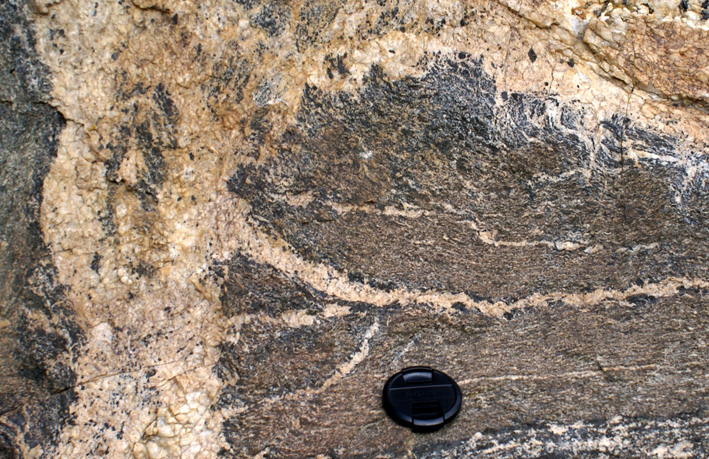| This page shows
distinct features
related to the partial melting of two outcrops in the Muglib pluton,
close to the village of Tangtse in Ladakh, NW India.
Tng60 N34o
03' 25.3" E78o
14' 13.3": NOTES FOR AUTHOR: a) new Hbl forming on old and new in leucos 779, c) mottled pattern indicative of melt extraction leaving behind large new Hbln ph 780-781 788-789 (excellent channelway), ph 793 show beautiful gradation from mottled to residual large hbl in leucocratic groundmass, to leucogranite escap, d) hbl aggregate 771, e) boudinage 797, f) typical mobile leucosome 768 Tng165 N34o 03' 08.7" E78o 14' 17.7" NOTES FOR AUTHOR: a) leucosome with melanosome rim ph 739 or 744 (feature not available for Tng60 because melting took place within pores in the rock as evidenced by mottled pattern, and not along sheets), b) 750 and 747, 753zoom melt extraction from pores to dyks with newly formed hbl porphyroblasts, c) 757 huge hbl porphyroblast |
| Interpretation of Tng165. In situ melting formed a leucogranite and the new growth of hornblende porphyroblasts as a peritectic phase. This growth took place preferentially along contact leucogranite-diorite and produced grains larger than 2cm across. The question is how did water gain acess to the rock? Leucogranite in this outcrop tend to parallel foliation. Could it be that they replicate or mark the water inflow path? DId the inlfow path then become the magma outflow path? |
| Interpretation of Tng60. Melting of diorite produced a leucogranite and peritectic hornblende. When preserved in the matrix the process produces the mottled diorite texture. Melt extraction from the interstices left hornblende porphyroblasts behind (Fig. 3). Hornblende grains are also extracted as solids with the melt but tend to separate further as aggregates at the contacts with the source rock (Fig. 5a) or form schlieren (Fig. 5b). |
